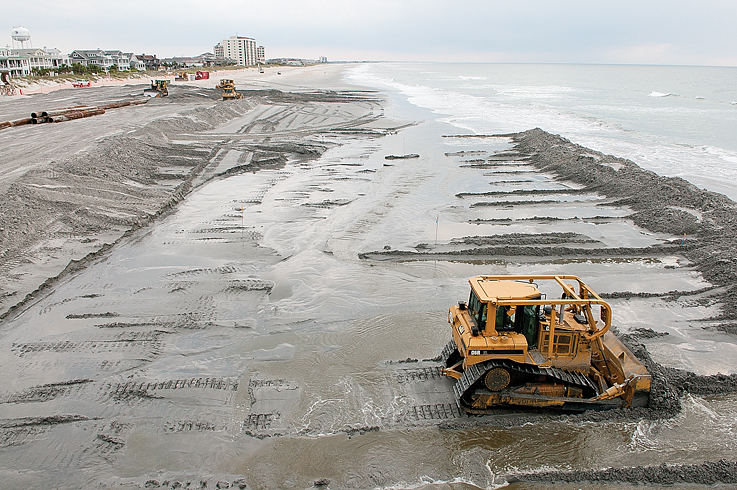Local coastal leaders, concerned about new requirements and unforeseen challenges added to the quest for federal financial support for coastal management projects, got an insider’s view of the workings in Washington on Feb. 11.
Fixed federal funds for multi-million dollar projects to regularly build up the dunes and extend the beach strand at Wrightsville, Carolina and Kure Beach was one of the main priorities discussed with lobbyist Howard Marlowe, president of Washington, D.C.-based Marlowe & Company, who represents the county on coastal issues. While meeting with Wrightsville Beach Mayor Bill Blair and Town Manager Tim Owens early in the day and attending the Feb. 11 meeting of the Wilmington-New Hanover Port, Waterway and Beach Commission, Marlowe touched on specific challenges included under the umbrella of sustained federal funding for the county’s three federally authorized coastal storm damage reduction, or beach renourishment, projects.
A clock is ticking for both Wrightsville Beach and Carolina Beach. The Wrightsville Beach project is approaching a total cost limit attached to its original 1986 federal authorization of $34.5 million over the project’s 50-year life. Roughly 30 years, seven completed renourishment cycles, and $22.1 million later, the Wrightsville Beach project is left with $12.4 million to last through 2036. Owens estimated the money will run dry in 2022, allowing only two more renourishment cycles.
The solution, Marlowe predicted, will probably involve a study of project costs and benefits and modified project authorization in a future Water Resources Development Act, legislation passed by Congress every two to seven years that provides a blueprint for coastal management projects. The previous two Water Resources Development Acts were spaced seven years apart.
“We have a challenge, not so much of whether you’ll get that increase, but when it comes, and making sure the funding cycles and the renourishment cycles continue on an orderly bases,” Marlowe said.
A coalition formed on behalf of about 10 other coastal storm damage reduction projects and 30 or 40 non-coastal projects facing the same challenge could generate momentum for a 2016 bill, Marlowe confirmed.
“There are a number of projects in the country, not just beach projects by any means, which are hitting their limits before the project authorization expires,” Marlowe said.
County shore protection coordinator Layton Bedsole asked Marlowe what role the county’s local delegation in Congress, namely U.S. Rep. David Rouzer, R-N.C., could play in ensuring a 2016 Water Resources Development Act bill.
“It is something the delegation can do. Your congressman is on the right committee,” Marlowe said, referring to Rouzer’s assignment to the House Transportation and Infrastructure Committee.
Responding to Bedsole’s inquiry of alternate solutions if a legislative action path falls through, Marlowe confirmed that while the legislative path is ideal, help could come through an appropriations bill in “dire circumstances.”
“This being the great country that it is … there is always another way to do things,” Marlowe said.
Legislative action spurred opportunities for the Carolina Beach project, which faced the end of its 50-year authorization in 2014. In a victory Marlowe attributed primarily to the county’s local delegation in Washington working with Congressmen from other states, the Carolina Beach project was extended through 2017 in the 2014 Water Resources Reform & Development Act, which also offered an opportunity to secure an additional 15-year reauthorization for the project. But because Carolina Beach is the first project to meet the end of its 50-year authorization, the process to secure the additional reauthorization is largely uncharted. Talking with the U.S. Army Corps of Engineers, Marlowe said he uncovers information bit by bit about what the process, already underway, will entail and who might ultimately make the decision.
Understanding how the Corps will calculate and use regularly updated cost-benefit ratios, a recent mandate, is another new variable thrown into the equation for all projects.
One of the main concerns from coastal communities is how the benefit-cost ratios will be used to “rack and stack” projects in the Corps’ request for federal funding each year. While Marlowe claimed past success securing funds for projects with lower benefit-cost ratios, the standard is generally a 2.5 — meaning $2.50 of storm damage reduction benefits are generated by every dollar spent. The Corps calculated a 1.4 ratio for the Wrightsville project when it was authorized in 1986.
email [email protected]




